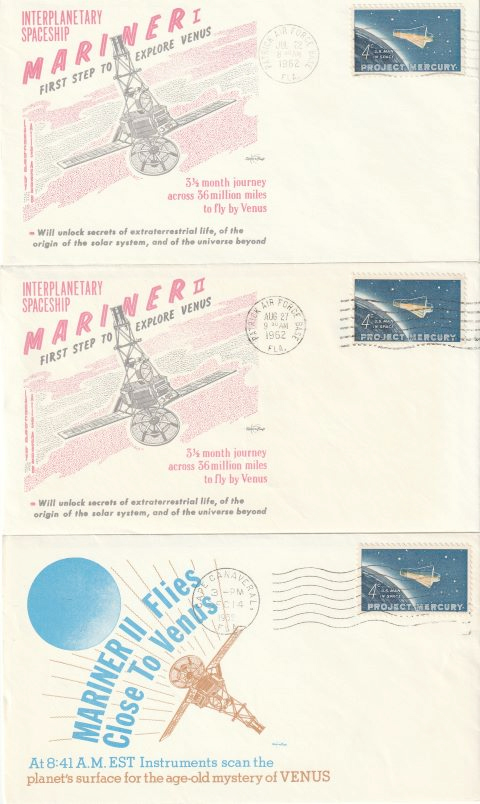Space Cover #65: Revisiting Mariner IIQuick, without looking it up: What planet did Mariner II fly by?
If you said Mars, your intentions were good, but heading the wrong way from the Sun! If you said Venus, congratulations!
cS member John Bisney had a book sale recently, and one that I picked up from him was a copy of a book that had fascinated me back when I was in elementary school. Project Mariner by Irwin Stambler and Gordon Ashmead was copyrighted in 1964 and printed by G.P. Putnam in New York, N.Y. After re-reading it 46 years later, I got fascinated once again with the history of Mariner II and will share a little of it here.
In the early 1960's the Russians and Americans were rushing to try to send unmanned probes to the nearby planets. The Russians made two attempts to send a probe to Venus in 1961, and neither succeeded. The Americans were planning to launch a 1000 pound spacecraft called Mariner A to Venus during the 1962 launch window, using the still-in-development Atlas Centaur launch vehicle. But by September, 1961, it became obvious to NASA that the Atlas-Centaur would not be ready in time for a 1962 launch. So, the Mariner design team at JPL had to rapidly come up with a 500 pound spacecraft that could be launched with the less powerful Atlas-Agena in 10 months! It became obvious rather quickly that scaling the Mariner A design down by one-half just was not feasible. So they took the already-existing design for the Ranger 3 moon probe, changed out the scientific instruments, and substituted magnesium everywhere they could in the structure to save weight.
On July 22, 1962, Mariner 1 was on the pad for launch, just 10 months after the redesign started. Unfortunately Mariner 1's launch vehicle strayed off-course and had to be destroyed by the Range Safety Officer. The ill fated Mariner 1 launch is commemorated on the SpaceCraft Cachet (SCC) shown at top, postmarked at Patrick AFB the day of the launch. Only 185 SCC's were made for this event, making it one of the rarer SCC's for collectors.
Fortunately the backup spacecraft, Mariner II, was ready and was successfully launched on August 27, 1962, as shown on the middle SCC, also postmarked at Patrick. Five-hundred of these SCC covers were made, making it a much easier cover for collectors to find.
The hastily-built Mariner II spacecraft proved to be temperamental on its four month flight to Venus, and gave the flight controllers little chance for rest. But on December 14, 1962, the plucky spacecraft became the first man-made spacecraft to approach another planet. It flew by Venus at an altitude of about 21,000 miles and took numerous scientific readings (no camera was onboard, so no pictures) of the planet and its atmosphere. The bottom SCC commemorates the flyby, and was postmarked at Cape Canaveral. Only 200 of these were issued - another tough SCC to find!
Mariner II's findings confirmed that Venus was an intensely hot planet with a surface temperature over 800 deg F, and shrouded in a thick atmosphere of carbon dioxide and sulphuric acid - not a likely spot to find life! After this mission, the planetary focus of the space race moved more toward Mars, where it was thought (and is still thought in some circles) that life could exist.
However, interest is now renewing in Venus, primarily driven by global warming concerns on the Earth. Venus is an example of global warming taken to the extreme, and scientists want to understand what happened there to better understand what could happen to Earth in the future.












